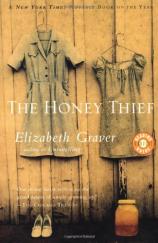Reading Group Guide
Discussion Questions
The Honey Thief

1. From the first chapter on, Eva's desire to steal forms a central strand in the novel. Why do you think she has this impulse? How is it related to the events of her early childhood? To her present circumstances? What is it allowing her to work out or stave off? What do you make of the fact that Miriam also stole when she was younger, as we see in her memory of her trip to Mexico (page 23)?
2. The Honey Thief takes place both in Manhattan and in a rural town in upstate New York. How is this dual setting important? At one point, as Miriam considers moving to the country, she remembers Francis scoffing at what he called "the Geographic Cure" (page 22). Was Francis correct in thinking that changing location is no solution to life's troubles? What effects does the move eventually have on Miriam's and Eva's relationship? On their individual development?
3. What is Burl's role in the book? What does beekeeping mean to him? To Eva? To their growing friendship? What compels Eva to open up the hive toward the end of the book? The world of the bees and the social world of people in the novel intersect in many ways. How would you describe those connections?
4. "She asked her mother questions," we read of Eva, "and her mother answered, and the answers both soothed and itched, so Eva asked again and yet again" (page 200). Why is Eva so interested in hearing stories about the past? What happens to those stories (for example, the one about how Miriam and Francis met, in Chapter Five) as they are told or remembered over time? What is the function of stories or memories about the past for the different characters in the book?
5. There are many instances, in The Honey Thief, of people lying, skirting around the truth, or omitting key details. Eva neglects to tell her mother about Burl; Burl covers up for Eva when Miriam asks him if she ever stole honey; Francis withholds information from Miriam about his illness. Most important, Miriam misrepresents the past to Eva. How do you understand the motivations behind these various dodgings of the truth? Should Miriam have been more straightforward with her daughter? What made her behave the way she did? What are the obligations, in a family or friendship, to reveal or withhold the truth?
6. Author Elizabeth Berg wrote that "in The Honey Thief, Elizabeth Graver captures the mixed pain and pleasure in the mother/daughter relationship [and] illuminates the sharp-edged longings of adolescence." A number of recent novels explore relations between mothers and daughters, among them, Jamaica Kincaid's Annie John, Elizabeth Strout's Amy and Isabelle, and Kaye Gibbons's Sights Unseen. What links do you see between The Honey Thief and these books or other recent novels about mothers and daughters?
7. Mental illness is a specter throughout the novel, most directly for Francis, but also for Miriam as she watches Eva grow up and worries that the child may have inherited her father's disorder. How does the novel explore what it's like to live under such a shadow? How does Francis's illness bring out or suppress parts of him? Of Miriam and Eva? Why is Miriam so worried that Eva might end up like her father? What is your evaluation of Eva's mental health?
8. Why do you think Elizabeth Graver chose to tell this story from three perspectives, instead of, say, sticking to Eva's perspective? How do the fears, hopes, and longings of Eva, Burl, and Miriam echo with or contradict each other? Why are we never given direct access to Francis's point of view? The book ends with Burl's perspective, as he watches Eva and Miriam at the observation hive. What has shifted by the end of The Honey Thief for each of these three people? How have these changes come about?
The Honey Thief
- Publication Date: September 28, 2000
- Paperback: 272 pages
- Publisher: Mariner Books
- ISBN-10: 0156013908
- ISBN-13: 9780156013901







